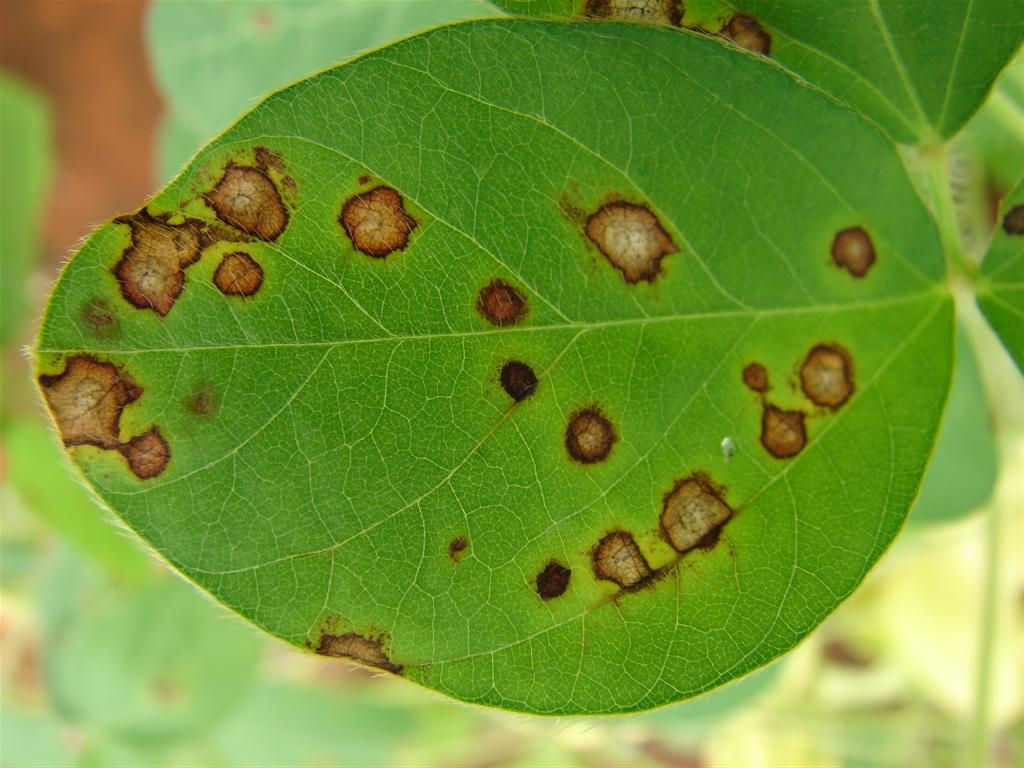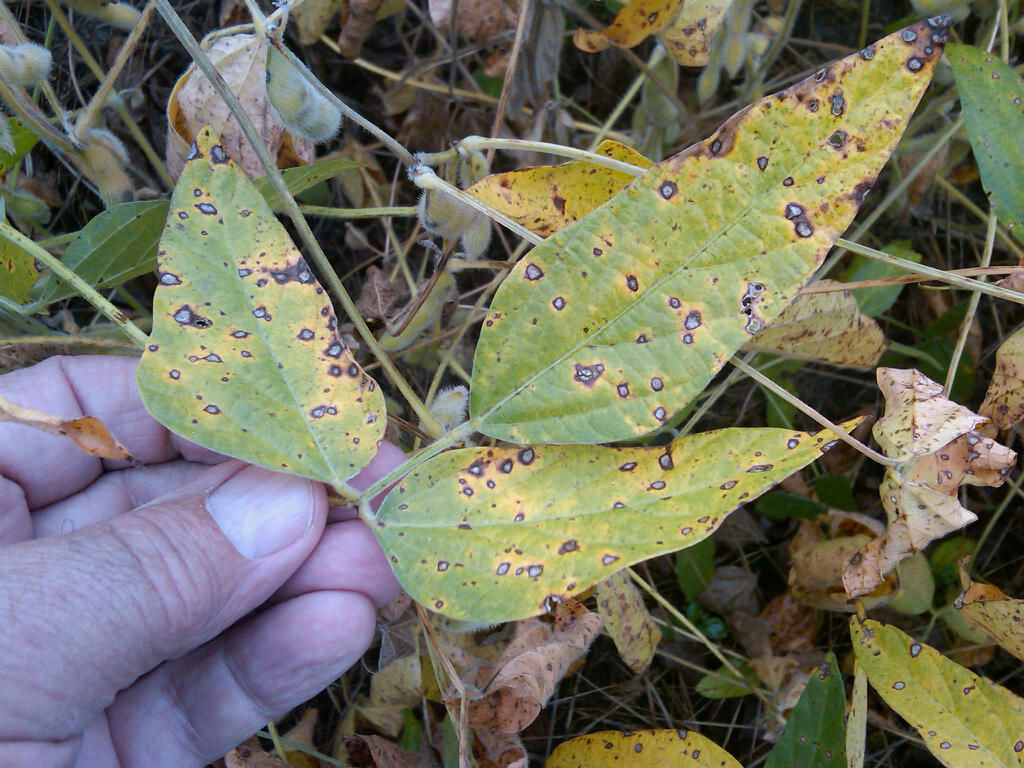5 MIN READ
Frogeye Leaf Spot
August 2, 2023
Frogeye leaf spot (FLS) is caused by the fungus Cercospora sojina, which survives on crop residue left on the soil surface. This disease occurs across the United States as well as in Ontario, Canada.1,2 The risk of FLS is greatest when soybeans are grown continuously in the same field, especially in reduced-tillage situations. The pathogen overwinters on soybean residue and seeds. Warm, humid weather promotes spore production, infection, and disease development. Spores are readily transported from one field to another by wind.
The risk for FLS is greater when:
- A susceptible soybean product is planted in a field with a history of FLS.
- Fields have continuous soybean production.
- Fields have short rotations between soybean crops.
- A conservation tillage or no-till production system is used.
Identification and Scouting
Planting infected seeds results in early-season infection and stunted seedlings. Although symptoms may begin at this early stage of development, frogeye leaf spot most often occurs after flowering. Scouting should begin around the flowering stage.
Early lesions appear as small, dark spots on the leaves. The spots are angular with light-gray centers and distinct purple to red-brown margins. Spots may coalesce to form larger, irregularly shaped spots. The lesions may appear to have small, dark hairs on the underside of the leaf, which contain the conidia (infecting spores of the fungus) (Figures 1, 2). Spores are produced from leaf lesions and additional infections continue if weather conditions remain conducive. Newly expanding leaves are more susceptible to infection than older leaves. In severe cases, lesions on pods and stems appear reddish brown and darken as they mature, but lack the characteristic, gray-colored center. Lesions on pods may appear sunken, and the seeds inside the pods may turn brown and have cracked seed coats.2


Impact on Crop Yield
The effects of frogeye leaf spot on yield potential can vary greatly depending on disease timing, soybean product resistance, and weather conditions during the reproductive stages. If the disease begins after the R5 growth stage or disease severity is low, the impact on yield is expected to be minimal. However, if weather conditions are favorable and there are severe disease outbreaks early or just after flowering, yield losses can be up to 35%.4
Management Options
Cultural Practices
Cultural practices can be used to manage frogeye leaf spot over the long term.
- When the disease is severe, tillage can help bury infested residue.
- Rotating away from soybeans to a non-host crop for two years allows time for the inoculum in the field to degrade before soybean is planted again.3
- Planting pathogen-free certified seed with FLS resistance can help manage FLS in-season.
Product Selection
The presence of FLS in the South has resulted in the development of several maturity group 5 and higher soybean products with FLS resistance.3
Fungicide Application
For fields planted with susceptible soybean products and high disease pressure, a foliar fungicide application can help protect yield potential. A forecast of 77 to 86 °F with prolonged dew or light rain favors disease development and would further justify fungicide applications.5
- Thresholds for fungicide recommendations vary by region, but fungicide application should be considered when 1 to 2 lesions are found every 25 feet of row at soybean growth stage R2.2
- Strobilurin-resistant strains of the FLS fungus have been reported in several southern states, rendering Group 11 (Strobilurins) fungicides ineffective at controlling these strains.6
- Delaro® 325 SC fungicide is labeled for frogeye leaf spot and includes two modes of action: prothioconazole (Group 3) and trifloxystrobin (Group 11).
- Delaro® Complete fungicide, with three modes of action (Group 3 (prothioconazole), Group 11 (trifloxystrobin), Group 7 (fluopyram)), is labeled for control of frogeye leaf spot.
- Delaro® 325 SC fungicide can be applied at early flowering or prior to disease development. Fungicide can also be sprayed at a 10- to 21-day interval when conditions favor disease development.
To learn more about Delaro® 325 SC fungicide, please visit https://www.cropscience.bayer.us/d/delaro-325-sc-fungicide and https://www.cropscience.bayer.us/d/delaro-complete-fungicide for information about Delaro® Complete fungicide or contact your retailer. It is important to check with your local Extension agent for application timing and fungicide recommendations in your region.
Sources
1 Bradley, C., Chilvers, M., Freije, A., Giesler, L., Mueller, D., Sikora, E., Sisson, A., Smith, D., Tenuta, A., and Wise, K. 2016. An overview of frogeye leaf spot. Crop Protection Network. CPN-1017. https://cropprotectionnetwork.org/publications/an-overview-of-frogeye-leaf-spot
2 Dorrance, A. and Mills, D. 2011. Frogeye leaf spot of soybean. The Ohio State University Extension. AC-53-10. https://ohioline.osu.edu/factsheet/AC-53
3 Westphal, A., Abney, T.S., and Shaner, G. 2006. Frogeye leaf spot. Purdue University Extension. BP-131-W. https://www.extension.purdue.edu/
4 Mueller, D. 2018. Mueller’s top 3 soybean diseases of 2018. Iowa State University. https://crops.extension.iastate.edu
5 Faske, T. 2015. Arkansas soybeans: Frogeye leaf spot — 3 key control points. University of Arkansas, AgFax. https://www.agfax.com/2015/08/21/arkansas-soybeans-frogeye-leaf-spot-3-key-control-points/
6 Reese, M. February 24, 2020. Will fungicide resistant frogeye be an issue for Ohio in 2020? Ohio’s Country Journal. Ohio Ag Net. https://ocj.com/2020/02/will-fungicide-resistant-frogeye-be-an-issue-for-ohio-in-2020/
1311_63272
Figure 1. Frogeye leaf spot lesions may coalesce to form irregularly-shaped necrotic areas.

Figure 2. Classic lesion symptoms with light-gray center and purple to brown margins.
You may also like...
Here are some articles that may also be of interest to you